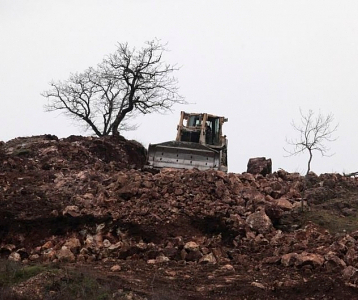
In December, 2014, an archaeological site in southern Georgia was destroyed by the Russian mining company RMG Gold. What was lost in the blasts at Sakdrisi?
Professor Thomas Stöllner at the University of Bochum in Germany is one of the people best placed to answer this question. A specialist in mining archaeology, he has been researching the Sakdrisi site for the last ten years.
The most interesting findings date back to something he and his colleagues call Kura-Araxes, a civilization which existed between 3,400 and 2,000 BC but whose existence has been known for only about a hundred years. Around a hundred sites have been studied so far, covering central and eastern Georgia, parts of Armenia, and also parts of Azerbaijan. There is no written record from this culture, so scientists have only the archaeological records to rely on.
-Why is the Kura-Araxes culture important?
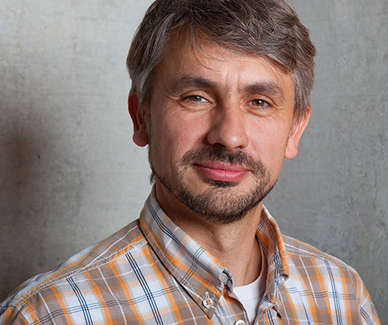
-For me, it’s important for two major aspects. First of all, it’s a cultural development that comes at the end of the late Chalcolithic period, when people already knew a bit of metallurgy and also had had Mid Eastern or Mesopotamian connections, which is typical for the time frame, the first half of the fourth millennium BC. And then we have the situation that all these old things have ended. So we have something new, and something which is very formal, in a way, in its cultural expression, which indicates that there was something going on with these populations.
-Around 3,000 BC, there are some new ideas rising, innovative ideas coming in, like metallurgy being again a very important point of cultural and societal display. And of course, during that period, these groups migrating, or people or bearers of this phenomenon, migrating to the fringes. So it is something, one could say, in Near Eastern culture it’s the only prehistoric cultural phenomenon that shows that the culture influence comes not from the so-called centers, like Mesopotamia, but from the Caucasian centers. This is very interesting. For example Arslantepe is a very important site, an urban site, where we have the grave of a king, perhaps, that integrated this cultural phenomenon, or Kura-Araxes artifacts, items, in his grave, which shows that these groups must have played a very important role. Either they might have been miners, they might have had knowledge about breeding cattle and sheep.
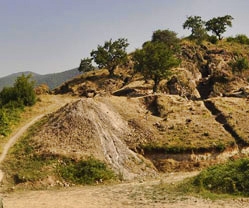
Our knowledge of the Kura-Araxes civilization is relatively sparse in comparison to other civilizations, almost enigmatic, Stöllner told DF Watch. Not many settlements have been completely investigated. The best ones are those in Georgia, some of them lie in Shida Kartli and Kvemo Kartli, where he is also carrying out research.
-There are still many open questions. That’s right. Because it is so different from other cultural phenomena in the same period, which is the North Caucasus and also the northern Mesopotamian Area.
What fascinates scientists about the Sakdrisi mine in particular is that it sheds light on how society was organized. Social organization in prehistoric times is mostly subject to hypotheses, as there is no written record. Many such societies may must have had a complex structure, although it usually doesn’t show up in the archaeological findings. Sakdrisi is an exception: Here there is more basis for theorizing about what kind of society it was, because there is a gold mine, a settlement and a graveyard, all in the same vicinity.
-What we can say from [studying] their sanctuaries, graves, [is that] there must have been a highly developed social organization. Sakdrisi is a condensed situation, because we have there a graveyard, a settlement which is quite large, compared to others, and we have a gold mine. In a way, it’s a whole landscape, which seems to have dealt with gold exploitation. And this is the first clear evidence of such a sophisticated organization in a society from this period. So it was amazing, outstanding. Of course, we already knew the importance of metallurgy in Kura-Araxes, but what we didn’t know was how sophisticated the technical stage of mining was, we didn’t know about all the different steps of work, in such a context, all these things. So this was really something new that we discovered around ten years ago, and since then we have been investigating this.
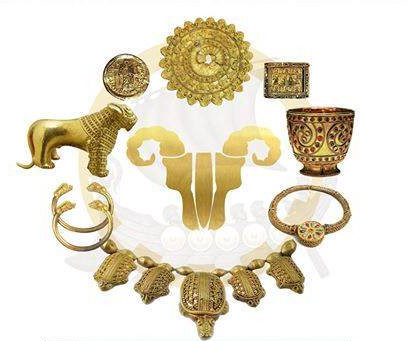
Clouds started gathering in the end of 2012, as a new coalition won the parliamentary election and came into government. Sakdrisi had had cultural heritage status since 2006, but the new government decided to give Russian mining company RMG Gold a license to commercially exploit the protected site.
As soon as the license was issued, the Sakdrisi site was cordoned off, and archaeologists could no longer enter as they wished. Then the new government tried to offer some of the Georgian archaeologists involved other opportunities in return for letting Sakdrisi go.
-As far as I know, they tried to ‘buy out’ the archaeologists, one could call it. To try to remove them by giving them some possibilities. But it was never discussed on a legal or professional level what to do with the monument, how we could make a heritage plan and so on.
It emerged that the new government led by then Prime Minister Bidzina Ivanishvili was disputing the notion that there was anything of archaeological value at the site. In the summer of 2013, the heritage status was lifted, after a government-appointed commission concluded that there were no traces of prehistoric mining.
-They said, ‘this is not really proven,’ and so on. Which is in a way astonishing, because we had already published in a lot of international publications, where we showed the evidence which had already been accepted by many scholars around the world, so we were first astonished of how this could be, because there was clear archaeological evidence. We had enough dating, enough archaeological findings. Of course, thousands of pebble tools and hammer tools.
It was a foregone conclusion, according to Stöllner. The commission had excavated in places where, according to his own research, there was only rock, with no scrape marks or anything indicating prehistoric mining. Later on, they were able to measure the trenches where the commission had dug.

-They were excavating in areas where we have also by our mapping stated that there was no mining activity. So it was a bit curious and strange. I think they were perhaps also forced to get these results, he says.
One of the members of the commission runs a rescue excavation company and was paid by Tadzari, an economic club in Bolnisi, which receives money from the RMG Gold people, he explains. In a way, there is a conflict of interest here. His Georgian colleagues claimed last summer that also other members of the commission somehow received money that originally came from RMG Gold.
-It’s not so easy to blame them alone, he says. In those days, there was a feeling in the society which divided people in two parts: Those who were with us, who got funding from for example Germany, and those people who did not have the possibility to take part in that. The society in Georgia is, there is a lot of jealousy around, and the pressure from the political side makes such a thing possible.
-It became very clear, even to some in the commission, that this was not a professional commission to find a solution. The goal, from my feeling, was to remove this heritage status. To make it legal to exploit it. But of course, some of the members of the government, for example [then Deputy Culture Minister Marina] Mizandari already understood that this is not a really good result, and they also asked us, and we also said, protested, that this was certainly not correct. Then we were assembled with the deputy minister, who tried to do her best. She had to leave her position, because she didn’t work as some members of government wanted her to. But we tried to work out something, and after weeks and weeks of discussion we were allowed to go to the site and to do some rescue work in 2013.
The team were then allowed back into the site for a few weeks, and were able to do additional documentation. But their work was hampered by harassment from the mining company, which had hired armed guards to deny archaeologists access to certain areas of the site.
-It was not nice, to put it mildly. Ok, nobody used force against us or threatened us, but it was an unfavorable situation for doing work with students there, with colleagues.
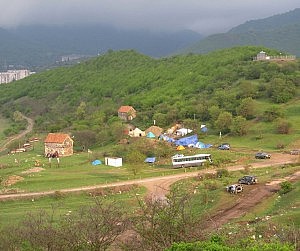 The German-Georgian team wanted to do a proper rescue excavation, but it was clear that this would be hard to organize in such a short time, and it would also require approximately one million of euro in funding. RMG Gold had made some funding available for rescue work early on, which is normal when historic sites are subject to commercial exploitation, but it is unclear where this money went.
The German-Georgian team wanted to do a proper rescue excavation, but it was clear that this would be hard to organize in such a short time, and it would also require approximately one million of euro in funding. RMG Gold had made some funding available for rescue work early on, which is normal when historic sites are subject to commercial exploitation, but it is unclear where this money went.
In the summer and fall of 2013, the conflict over Sakdrisi made the news in Georgia, as environmentalists became involved, especially a youth group called Green Fist. The activists demonstrated in Tbilisi and later in a protest camp they put up at Sakdrisi. The government on its part allowed another group of scientists into the site, without informing the German team.
-The excavation in the autumn of 2013 was also a fake excavation, to be honest, just to tell us that we have a good argument but that our work was not scientific.
But the conflict remained unsolved. In spring of 2014, there was increased pressure from environmentalists in Green Fist and from people abroad, and the campaign to save Sakdrisi gathered steam. The government put together a second commission, consisting of two foreign sciensits – one mining archaeologist and one geologist – who concluded that there was indeed important archaeological material there.
It was in this connection that Stöllner for the first time met personally with representatives of RMG Gold, a year and a half after all this began. The German team had a public presentation where all the parties were invited to the site, and given a demonstration of how to exploit gold using ancient techniques that had been reconstructed. The culture minister and his deputy was present, as were representatives from RMG and others.
For some months at least, it looked like the tide was turning. They were in negotiations with the National Museum about a real rescue plan to finalize work, and eventually agreement was reached in the summer of 2014. Around the same time, a Georgian court issued an order which halted further mining work until the conflict had been settled.
As Stöllner went back to Germany, the Green Fist activists kept watch from the protest camp, weary that the company would begin work.

Then on December 12, 2014, explosions were heard from the site. Work had resumed. The National Agency on Protection of Cultural Heritage issued a decree which permitted RMG Gold to resume work. In a statement, the company referred to the decree and said the decision was based on the fact that part of the site has been fully researched by archaeologists and the rest of the area wasn’t possible to research due to the alarming condition and the threat of collapse. In addition, RMG Gold said, international scientists had concluded that there was not likely to be found any more artifacts there.
While the site remained closed off, RMG Gold said that the archaeologically interesting parts had now been destroyed, so further salvage work was pointless.
The destruction, which the German team has not been informed about beforehand, caused an outrage in Georgia, and even Patriarch Ilia II scolded the government for having allowed it to happen. The issue was also brought up in parliament, where a majority voted for an inquest into what happened.
As previously reported by DF Watch, this decision has been sabotaged by members of the governing Georgian Dream coalition. While the government has tried to convince the public that it was necessary to exploit Sakdrisi because of the jobs it creates for locals in the area, opposition parties have raised the inquest issue several times in parliament. Representatives of Georgian Dream have claimed that the National Movement is using the issue about the gold mine to turn people against the government.
Ahead of one of these debates in parliament, Stöllner was asked by the National Movement party to write a statement, which was published on the website of Guria News. At a press conference, the National Movement’s Sergo Ratiani quoted from his letter, in which the destruction of Sakdrisi is compared to the Taliban’s destruction of the Buddha statues at Bamyan, Afghanistan in 2001.
-Georgian politics is very polarized. You could be used in a dirty fight between the different wings of politics?
-Yes, of course. I know that. But I was officially contacted by a committee of parliament, led by Sergo Ratiani, and I was asked officially if I could give a statement. And I did. But I really don’t want to be part of this game. But I can feel that we all are now part of this game. The only thing we can do is to make an honest statement about the whole situation. To give a scientific statement. I really don’t want to go into these political troubles.
-It must be frustrating for archaeologists to see that a government deliberately destroys a very important site?
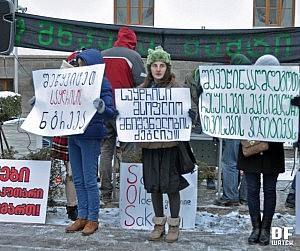
-Of course it is. No doubt. In the end, you try to find a compromise. For archaeologists, we can understand all the arguments, also from the economy. In Germany we have big projects being done in such situations, so there is destruction because there is demand to use the land for something. You always will have such situations, so you have to find a solution. So what society has to decide is if the monument is important enough to protect it. If it is not that important for the society or international community, you may destroy it, but we should investigate it properly. And none of these arguments have been dealt with seriously. And this is something that I am a little bit frustrated about, for we fought for two years to find a solution, but we couldn’t. In the end, we said, OK, we did one quarter of the excavation, we have good data which we are controlling, and we will publish. At least we will use the evidence we have to build up a museum.
-Is there anything left to save at Sakdrisi?
-I’m not sure how far the exploitation is going. Of course, the site will never be how it was when we first found it ten years ago. In those days, if you would have invested money as other countries do, you could have made an archaeological park or something like that. You could have used it for tourism. But I fear now, after having destroyed it and having exploded at least the upper part of the mine, the part which is lower down in the earth is still there, imagine what people would like to see there, so I am a little bit puzzled by this question. I think that the best for society at least will be to work to build up a museum, and to tell the story which I have told you, to keep this in memory. To not do the same mistake again. Even with RMG you would have had a possibility to make a good deal which is helpful for both parties. There is so much time which has been lost, so much money which went for corruption. If they had used that money to do the proper work then there would at least have been something. And though this is something which has hurt everybody who was dealing with it, it has cost a lot of time, energy, and brought also many losses in money for the company. So it was not really a victory for anybody. So it was something which you wouldn’t like to have happen, also in a society. It split society in a way. In this respect I would say it was just bad management. Something which one could do much better if one knew how to do and keep to society’s rules. This could be kept in a museum to tell the story of the Kura-Araxes culture, which is also a Transcaucasian culture. Perhaps next time, the «next Sakdrisi» you would make it better. This is my hope, Stöllner says.
When asked about the issues raised in this article, RMG answered: “RMG does not intend to answer Thomas Stöllner’s absurd inquiries.”
The Culture Ministry was also contacted for comment, but did not contribute.

